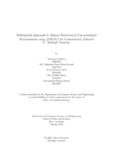Multimodal approach to human detection in unconstrained environments using YOLOV7 for conventional, infrared & thermal cameras
Date
2023-01Publisher
Brac UniversityAuthor
Rukaiya, MaymunaKhan Soumik, Md. Muhtadee Faiaz
Sakib, Sazzad Hossan
Islam, Md. Ashikul
Ishrak, Mohammad Farhan
Metadata
Show full item recordAbstract
Search and rescue operations in disaster-stricken areas are often hindered by chal lenging environmental conditions, such as poor visibility, limited lighting, and high
levels of noise and clutter. These conditions can make it difficult to locate and res cue survivors in a timely manner, which can have significant implications for their
survival and recovery. Traditional methods of human detection, such as visual obser vation, can be ineffective in these environments, and new and innovative approaches
are needed to address these challenges. This research presents a novel multimodal
approach to human detection in unconstrained environments using YOLOv7 for con ventional, infrared and thermal cameras. The proposed approach aims to improve
human detection performance in challenging environments, such as post-disaster
situations, where traditional methods may fail. A unique dataset of 7,087 images
was created for this research, including both conventional and thermal images, which
were collected to capture the realistic scenario of disaster environments. The dataset
was used to train various CNN models for human life detection, and the results were
evaluated using standard metrics. Additionally, to further enhance the search and
rescue operations in post-disaster situations, a Bangla speech recognition model was
integrated into the system. The results of this research demonstrate the effectiveness
of the proposed approach in detecting humans in challenging environments, such as
low-light and obscured conditions. The use of thermal imaging in particular, has
the potential to significantly improve human detection in disaster scenarios where
visibility is limited. This research provides a valuable contribution to the field of
human detection in unconstrained environments and has the potential to improve
search and rescue operations in the future.

